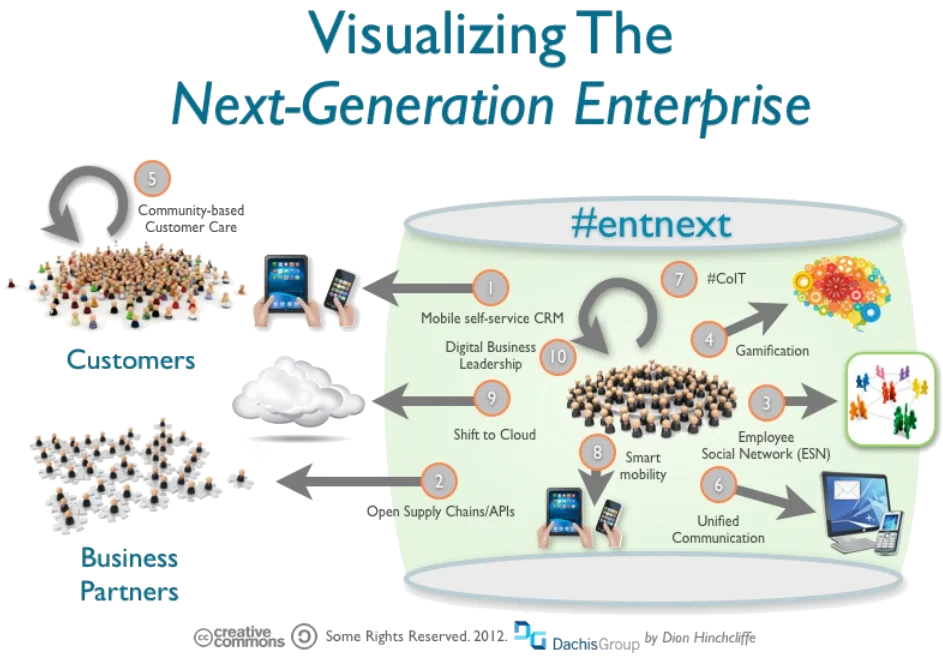How digital natives achieve a competitive edge over incumbent enterprises




Digitally native companies have become extremely attractive to investors over recent years (Broitman, et al., October 27, 2021). The reason is quite simple – digital natives grow three times faster than overall e-commerce on average. The fastest-growing digital natives have scaled from $50 million in revenues to $1 billion in just 4-8 years.
However, not many digitally native businesses become successful. Over the past two decades, less than 0.5% of digitally native brands have reached $100 million in revenues, and more than 90% currently earn less than $1 million annually. Still, there’s a lot we can learn from digitally native businesses.
The phrase “digital native” was first coined by Mark Prensky (2001). Digital natives are incredibly agile and enjoy immense customer loyalty, which creates struggles in many businesses. With that, what can traditional businesses gather from the experience of digital natives? How can non-native organizations compete with them for customers? Below, we will explain the advantages of digital natives and outline precisely how they achieve an edge over traditional businesses.
What is a digitally native company?
The concept of a “digitally native company” has no formal definition. Many consider digitally native organizations to be companies that have started their operations online (Newton, November 13, 2020), and some consider them to be companies that operate exclusively or mostly in the digital space (Victor, October 9, 2019.). Table 1 outlines a provisional breakdown of the generations involved across the range of traditional (classical) enterprises and digital enterprises.
| Generations | Date Range | Nickname (aka) |
|---|---|---|
| Baby Boomers | Born 1946-1964 | Flower Children |
| Generation X | Born 1965-1980 | Lost Generation, Sandwich Generation, or MTV Generation |
| Generation Y | Born 1981-1996 | Me Generation, Millennials, or Peter Pan Generation |
| Generation Z | Born 1997-2012 | Digital Natives |
| Diginauts | Born 2013 — present | Children of the children of astronauts, cosmonauts, & taikonauts |
Definitions can be confusing – fortunately, there’s no need to pay too much attention to them. While existing definitions can vary broadly, they all share one notion – digitally native companies heavily use digital technology in their day-to-day operations. Many digital natives conduct business exclusively online, though being native to the digital world doesn’t necessarily exclude physical operations.
“Digitally native brands (DNB) are maniacally focused on the customer experience and they interact, transact, and story-tell to consumers primarily on the web.”
— Andy Dunn, CEO, Bonobos
Many companies have developed their own definitions to clarify what digitally native businesses are. Professional services company EY, as an example, points out the following three features of “digital native” organizations (Watt, Jul 22, 2020):
- Digitally native organizations were born and have grown up in the digital age. Their structure and strategies have been heavily influenced by digital technology.
- Digitally native organizations have adopted disruptive thinking to innovate and introduce new solutions to meet the needs of their customers.
- Digitally native organizations can effectively leverage the opportunities of the digital age, unlike traditional companies that can struggle to adapt to today’s fast-paced business environment.
Consulting company eBusiness Institute (2022) proposes that digitally native businesses:
- Interact with their customers primarily through the web.
- Are vertical brands and oversee every step of their product experience, from production to consumption.
- Highly value consumer experience and customer intimacy.
- Are rarely digital-only.
The concept of a “digitally native company” is related to the concept of a “digital native.” Digital natives are people who are on excellent terms with digital technology – like computers and smartphones – because they have grown up with it. The first generation of digital natives was Zoomers – people born in the late 90s or early 2000s (Shapiro, Dec. 6, 2017).
Concept-wise, digitally native companies are an extension of digital natives, but at a business level. As far as business is concerned, digital “nativeness” extends to an organization’s structure, business values, and core capabilities.
How do digitally native companies differ from traditional businesses?
Digital natives differ substantially from old-school businesses. Thanks to these differences, digital natives can better navigate the harsh landscapes of the digital era. Digital natives are most often contrasted with digital immigrants and their enterprises.
This quick Prezi presentation by Alyssa Claire Lu provides a useful differentiation between the two.
There are two areas where the differences between digital natives and traditional businesses are perhaps the most prominent:
- Organizational approach – determined by how a business approaches its employees, customers, and work processes.
- Organizational structure – determined by how the organization is built and how its units interact.
Let’s look at how digital natives and non-natives differ in these areas.
"…the behavioral characteristics of digital natives are exhibited in ways that often may be in contrast with other generations. … Many of the differences … [create] potential tensions that might arise as the digital natives join organizations that have structures and norms that were designed (or evolved over time) to serve the needs and behavioral norms for earlier generations."
–Robert Mason, Karine Barzilai-Nahon, & Nancy Lou (April 2008).
Organizational approach
Digitally native businesses are incredibly customer-centric and passionately promote healthy work environments. They do this by following these five approaches (Watt, Jul 22, 2020):
- Mindset over skillset. Although digital natives do value employee skillsets, they put a much bigger emphasis on employee mindset. An employee’s skillset shows what they can do now, while the mindset displays their desire and potential for learning and continuous self-improvement in the long run. This mindset essentially means that digitally native companies consider their hires from the standpoint of their long-term potential.
- Continuous feedback and learning. Digitally native companies view continuous learning and growth as the keys to their success. Digital natives are not afraid to fail often and fail fast. Challenges and failures allow digital natives to analyze their current capabilities and to make effective changes toward improvement. The growth mindset plays a crucial role in feedback and learning, which is why digital natives value employee mindset over skillset.
- The obligation to innovate. In digitally native companies, innovation is not the responsibility of a chief innovation officer or a dedicated innovation team. Instead, the duty to innovate is ingrained in the mindset of every employee, allowing digitally native companies to be wholly dedicated to driving innovation.
- Organization-wide customer service. To some extent or another, everyone in a digitally native company is involved in customer service. Digital natives give great weight to customer satisfaction and have thus adopted an organization-wide approach to customer service. They pay great attention to both their critics and supporters and engage heavily with either. Digital natives also heavily use technology to profile and understand their customers, further enhancing their ability to meet customer needs.
- Connected work environments. Collaboration and productivity enable continuous growth, superior customer service, and business success in digital natives. Digitally native companies carefully design connected workspaces to foster communication and hence innovation.
Now, these approaches are not exclusive to digital natives –many pre-digital era companies have also adopted them to adapt to the requirements of modern markets.
However, the critical difference here is that the five approaches are embedded in the DNA of digitally native businesses. Digital natives are born with technology and adopt a more agile way of operating from the very beginning. In contrast, classical organizations appeared in times when they didn’t need to adapt to quickly changing market conditions to be successful.
Before digital technology became widespread, businesses didn’t need to compete across geographies, and they weren’t able to drive innovation as quickly as they can do it today. Competition between businesses was much less fierce than it is now. Globalization and the development of technology changed things drastically. Businesses now need to offer value, quality, and excellent customer experience to grow and survive. They also need to keep a close eye on changes in the industry, and customer needs to be able to adapt to them.
Agility, continuous improvement, and customer-centrism are the keys to longevity in today’s business landscape. Many classical businesses have realized this and have already made changes to their organizational approaches and structures accordingly. Consequently, even though both digital natives and classical organizations can be agile and customer-centric, the latter has to rethink the way they do business to stay relevant. In this sense, digital natives have a huge head start, and not many traditional businesses can catch up.
Organizational structure
Digitally native businesses are mostly hierarchical, though they are not as rigid as traditional organizations. Digital natives typically don’t forgo hierarchy because of its benefits for organizational clarity and stability. However, despite being hierarchical, digital natives are more reactive than traditional companies because they emphasize employee engagement, growth, and innovation. Whenever possible, digital natives incorporate more agile elements in their processes.
Instead of being hierarchical, some digital natives might choose to go fully agile. An agile organization ditches the standard top-down hierarchy in favor of a flatter organizational structure where teams can interact with each other more freely (Aghina, et al., January 22, 2018). But even though the agile organizational structure provides excellent responsiveness and flexibility, digital natives tend to use agile approaches only in specific areas of their operations, like software development. Whenever reasonable and practical, digitally native businesses choose the clarity provided by hierarchy.
Can a classical business become like a digital native?
Generally, native businesses can navigate technology-enabled market landscapes much more efficiently than classical businesses can. Digital natives are more flexible and can better use software tools to pursue their goals. With all that said, can a traditional organization adapt its structure and technology infrastructure to become like a digital native? Figure 2 suggests the concept map for the Next (Digital Native) Enterprise.

Digital transformation is the way toward digital “nativeness”
The answer is as follows – with digital transformation, organizations that have chosen to remain offline can make their way into the digital world. A physical-only store chain can quickly launch a website and offer online shopping to its customers. Many offline businesses had to go online to survive the harsh lockdowns caused by the COVID-19 pandemic.
However, to become a digital native, it is not enough to go online. Making steps toward online presence is a fundamental starting point. Nonetheless, businesses need to optimize their operations and structure carefully with digital technologies in mind to achieve native-level agility and performance.
Digital transformation needs to be done step-by-step
Digital natives are born in digital technology. Software, code, and cloud tools are built into their organizational structure and operations when they launch. Technology is a vital part of digitally native businesses and thus seamlessly integrates with all aspects of their operations.
In contrast, traditional organizations have originally been offline. The founders of classical organizations most likely have never even considered that their approaches to business would one day become obsolete. Siloed processes, disconnected departments, and little to no data analytics were frequent in business’s “classical” era.
As classical organizations grew, acquired other businesses, and expanded their operations, they became more complex and, in many cases, less efficient. With years and years of bad practices piled on top of each other, classical organizations became more challenging to manage and more costly to operate. Despite this, accustomed to broken processes and isolated departments, many businesses made their horribly inefficient operations work.
For these businesses, digital transformation is a gargantuan task. They can’t just throw years of established practices out of the window and replace them with digitally-enabled workflows. They’ve lived with bad processes their whole lives and have become reliant on them, so switching to digital technology is no easy feat.
All this means is that classical businesses have to work to digitalize themselves. They need to do this step-by-step – otherwise, they might accidentally shatter the already fragile foundations of their operations.
Next steps
Not many digitally native businesses make it because many of their seemingly innovative ideas are, in reality, impractical or unnecessary. But those digital natives who manage to establish a strong footing in their industries often reach immense success and achieve it fast. IDC (2017) identified six innovation accelerators for future digital transformation: internet of things, augmented and virtual reality, cognitive/AI systems, next-generation security, 3D printing, and robotics. We have witnessed how digitally native businesses have adopted virtually all of these innovations in producing new products and services.
Classical businesses find it very difficult to compete with digital natives in customer care and innovation. But even though the challenge is enormous, traditional firms can and should take steps toward digital fluency. They will not survive the ultra-competitive modern markets otherwise.
Furthermore, classical businesses should not try to digitalize their operations all at once. If they do try to change too many things simultaneously, they will most likely just get crushed by the amount of work that needs to be accomplished. Digital transformation can be very beneficial in the long term, but it is neither easy nor fast.
Non-digital businesses should start digital transformation small – maybe at the level of an individual process or department to minimize risk and continue operating reliably. Then, as they gain experience and deeper insight into their capabilities, businesses can freely extend digitalization to the rest of their organization.
References:
Aghina, W., Ahlback, K. De Smet, A., Lackey, G., Lurie, M., Murarka, M., & Handscomb, C. (January 22, 2018). The five trademarks of agile organizations. McKinsey Report. https://www.mckinsey.com/business-functions/people-and-organizational-performance/our-insights/the-five-trademarks-of-agile-organizations
Broitman, A., Hunter, E, & Schmidt, J. (October 27, 2021). Digitally native brands: Born digital, but ready to take on the world. https://www.mckinsey.com/industries/private-equity-and-principal-investors/our-insights/digitally-native-brands-born-digital-but-ready-to-take-on-the-world
eBusiness Institute. (2022). What are digital native brands (DNB)? https://ebusinessinstitute.com/digital-native-brands/
Hinchcliffe, D. (May 29, 2012). On Digital Strategy: This Year’s Ten Digital Strategies for the Next-Generation Enterprise. https://dionhinchcliffe.com/2012/05/29/this-years-ten-digital-strategies-for-the-next-generation-enterprise/
IDC. (2017). Preparing for the Digital Transformation Economy: The Tools Needed to Build a Digitally Native Enterprise. IDC.
Mason, R. M., Barzilai-Nahon, K., & Lou, N. (2008, April). The organizational impact of digital natives: How organizations are responding to the next generation of knowledge workers. In Proceedings of the 17th International Conference on Management of Technology. (pp. 1-14).
Newton, C. (November 13, 2020). Digitally Native Vertical Brands (DNVB): Everything Should Know. Klaviyo. https://www.klaviyo.com/blog/dnvb-digitally-native-vertical-brand
Prensky, M. (2001). Digital Natives, Digital Immigrants Part 1, On the Horizon, 9(5), 1-6. https://doi.org/10.1108/10748120110424816
Shapiro, E. (Dec. 6, 2017). TV: An Intervention. Huffpost Blog. https://www.huffpost.com/entry/tv-cord-cutters_b_1568919
Victor, R. (October 9, 2019). 50+ Digitally Native Companies. Hollingsworth Resources. https://www.hollingsworthllc.com/50-digitally-native-companies/
Watt, M. (Jul 22, 2020). How digital natives are influencing traditional organizational design. EY. https://www.ey.com/en_gl/workforce/how-digital-natives-are-influencing-traditional-organizational-design


